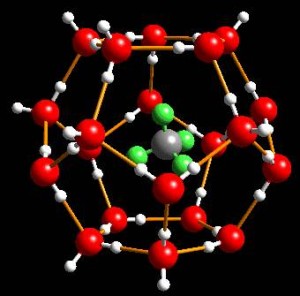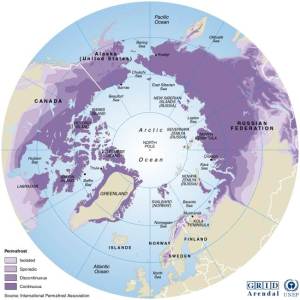Methane Hydrates
Methane hydrates are odd little things. They are a cage of ice enclosing a single molecule of methane.
 In the image on the right from the University of Göttingen, GZG. Abt. Kristallographie, a hydrate (or clathrate) structure is shown; water molecules are shown as red and white, methane as gray and green.
In the image on the right from the University of Göttingen, GZG. Abt. Kristallographie, a hydrate (or clathrate) structure is shown; water molecules are shown as red and white, methane as gray and green.
Click on figure to enlarge.
Methane hydrates form over centuries as organic matter decays. They occur in the permafrost of the northern hemisphere and on continental shelves of the oceans at depths where the ocean is cold enough and/or pressures are high enough. Hydrates on continental shelves offer a potential resource to energy-starved Japan, although it is still not clear that hydrates can be produced economically or in an environmentally-safe manner.
Melting of hydrates would release methane which would exacerbate climate warming. The extent of permafrost is vast in the northern hemisphere as seen on the figure to the right.
The figure, from the International Polar Foundation, is a view of the globe looking down on the north pole showing areas of permafrost in purple. According to Schaefer et al., 2011, permafrost underlies 8.8 million square miles of the northern hemisphere landmass. They estimate that the release of carbon from permafrost could reach 190 billion tons by 2200, which in turn would increase global temperature by an additional 3°C.
Clearly we want to avoid getting to that stage.
Click on figure to enlarge.
A simulation by Lawrence Berkeley National Labs shows the melting of permafrost. The LBNL modeling of the interplay of increased vegetation with warming in the Arctic, which will take up carbon, and the release of carbon from melting of permafrost, shows that the latter will “win handily”.

